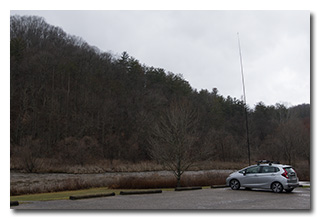
by William Eric McFadden
From the Strouds Run State Park website:
-
Several mounds and ancient fortifications were found in this area by early settlers telling us that the Adena Indians once lived here. In more recent history, this was home to the powerful Shawnee Nation until the Treaty of Greenville forced them to abandon their lands in southern Ohio.
The first settlers arrived in the Athens County region in 1796. Two townships of land in the area had been apportioned by the Ohio Company in 1795 for the benefit of a university. Settlers were encouraged to settle on these college lands so as to make them attractive, productive and to form a fund for the institution.
This venture led to the founding of the town of Athens and Ohio University, the first college in the Northwest Territory. Settlers came by way of flatboats from Marietta down the Ohio and up the Hocking River to an attractive bluff where the town of Athens is now located.
With the discovery of rich coal fields in the area, Athens County soon developed into one of the leading coal producers in the state. The Hocking Canal and railroads provided easy means for shipping coal to distant markets. Clay tile, brick and salt were other industries that brought prosperity to the area.
The park derives its name from the Strouds family who settled in the area in the early 1800s. The land was purchased by the state for forest conservation purposes from 1948 to 1953. The dam creating Dow Lake was completed in 1960. The lake bears the name of C.L. Dow of Ohio University who was instrumental in initiating the project.
Pictures
Description
On Sunday, January 7, 2024, one member of the Southeast Ohio Radio Adventure Team performed a successful activation of Strouds Run State Park (K-1994) as part of the Parks on the Air (POTA; link) program.
 Eric arrived at the unoccupied Bulldog Shelter at about 1530 UTC. Parking his car at one end of
the parking area, Eric deployed his 28½' wire vertical on his 31' Jackite fiberglass
telescoping mast on a drive-on base and, because of the drizzle and the cold temperature (37°F),
he deployed his Elecraft KX3 inside his car. Eric was on the air at 1536 UTC.
Eric arrived at the unoccupied Bulldog Shelter at about 1530 UTC. Parking his car at one end of
the parking area, Eric deployed his 28½' wire vertical on his 31' Jackite fiberglass
telescoping mast on a drive-on base and, because of the drizzle and the cold temperature (37°F),
he deployed his Elecraft KX3 inside his car. Eric was on the air at 1536 UTC.
As expected, Eric found he had good cell-signal at this location and he would be able to spot himself on the POTA Spots website and to use POTA Spots to identify possible Park-to-Park (P2P) QSOs.
Eric began his operation on 20m. Finding himself a clear frequency to run, Eric began calling "CQ POTA" and was auto-spotted on POTA Spots. Eric's first QSO came at 1538 UTC with K6KMH in California. QSOs came very quickly, with Eric's fifty-fourth QSO coming at 1630 UTC with KY4YQ in South Carolina. This long run included a P2P QSO with N4CD who was activating Spring Creek Forest State Preserve (K-4423) in Texas and QSOs with operators located in France, Germany, Denmark, California (2), New York, Texas (8), Washington, Florida (4), New Hampshire (2), Iowa, Louisiana, Maine, Arkansas, Colorado (2), Alabama (2), New Jersey (4), Massachusetts (2), Michigan (3), Virginia, Texas, New York (4), Georgia (2), Kansas (2), Wisconsin (2), Pennsylvania, Illinois, Oklahoma, and South Carolina.
Switching to 40m, Eric found a clear frequency to run, began calling CQ, and was again auto-spotted on POTA Spots. His first QSO in this run came at 1634 UTC with KN4XP in North Carolina. QSOs came quickly, with Eric's thirteenth QSO in this run coming at 1646 UTC with K3NCE in Maryland. This run included QSOs with operators located in North Carolina (2), New York (2), Wisconsin, Missouri, Ohio, Michigan, Pennsylvania, Ontario (2), and Maryland (2).
In all, Eric made sixty-seven QSOs, with one P2P QSO, in seventy minutes of operating time. All of Eric's QSOs were CW and were made at five watts output.
Eric also submitted his log to the World Wide Flora and Fauna in Amateur Radio (WWFF; link) program for an operation at Strouds Run State Park, KFF-1994.
(return)